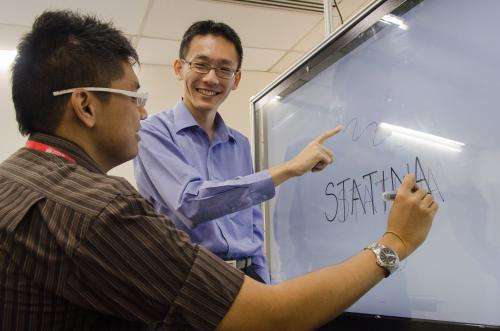Invention transforms plain surfaces into low-cost touch screens

Imagine turning a whiteboard, glass window or even a wooden table top into a responsive, touch sensitive surface. A low cost system developed by Nanyang Technological University (NTU), based on the principles of vibration and imaging that is able to track the movements of multiple fingers and of objects, can do just that.
Retrofitting the system onto existing flat-panel TVs will transform it into new, touch sensitive display screens, at only a fraction of the cost of new touch-sensitive display screens, which can cost tens of thousands of dollars.
Once hooked up to a computer, the modified TV screens can then be used as interactive billboards, mall directories and even as a digital whiteboard which can track what is drawn or written.
NTU Assistant Professor Andy Khong, who led the research, says this award-winning system has been proven on different types of large surfaces. The team won the Prestigious Engineering Achievement Award 2012, presented by The Institution of Engineers Singapore (IES) last December.
"Our innovative system is able to transform surfaces such as wooden tables, aluminium, steel, glass and even plastics into low-cost touch screens. It means in future, you could play computer games or draw sketches on walls or windows since almost all surfaces can be made touch-sensitive with our system," says Prof Khong.
The technologies developed for the system have already led to several academic publications, patents and conference papers. The latest research findings were published earlier this month in the Institute of Electrical and Electronics Engineers (IEEE) journal. IEEE is the world's largest professional association for the electrical and electronics industry and its journal is renowned for its peer reviewed and quality research papers.
How it works
Named STATINA (Speech Touch and Acoustic Tangible Interfaces for Next-generation Applications), this interdisciplinary research project exploits principles of vibration waves propagating on a solid surface.
By using a few low-cost vibration sensors and a specially developed algorithm, the system can pinpoint the location of a light tap on any surface. When further equipped with low-cost web-cameras, this system can also track the movements of multiple fingers or objects on any surface.
Since sound waves propagate through matter at a certain speed, it is possible to derive the location of the touch based on when each sensor picks up the signal, Prof Khong added.
In addition to understanding the mechanics behind solid wave propagation, the scientists had developed a unique signal processing algorithm to figure out the exact location of the initial point of impact.
Future plans
STATINA is the culmination of Prof Khong's research spanning the last four years. He and his team of researchers are now working to commercialise their invention by developing a more compact system and expanding its capabilities to include tracking of fingers and stylus movements using optical cameras.
So far, they have tested their system on surfaces such as wooden tables, aluminium, steel, glass and plastics.
Initially funded by the Media Development Authority (MDA) under the National Research Foundation (NRF) Co-Space grant call, the team has also recently been awarded the NRF Proof-of-Concept grant, which awards innovative research of up to $250,000 for the development of a commercially viable prototype based on their initial research. They are also working with the Institute of Technical Education under the Ministry of Education Translation Innovation Fund (MOE-TIF).
More information: Reju, V. et al. Localization of Taps on Solid Surfaces for Human-Computer Touch interfaces, IEEE Transactions on Multimedia.
Provided by Nanyang Technological University





















